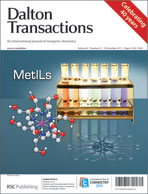Vibrational modes and structural characteristics of (Ba0.3Sr0.7)[(ZnxMg1−x)1/3Nb2/3]O3 solid solutions
Abstract
(Ba0.3Sr0.7)[(ZnxMg1−x)1/3Nb2/3]O3 (BSZMN) (x = 0.0, 0.2, 0.4, 0.6, 0.8, 1.0) solid solution ceramics were synthesized by the conventional solid-state sintering technique. ![[3 with combining macron]](https://www.rsc.org/images/entities/char_0033_0304.gif) m1, where x ≤ 0.4) to the pseudocubic phase (I4/mcm, where x ≥ 0.8) with increasing Zn2+ content. The phase transition is a gradual process, the sample where x = 0.6 is of the transition phase, i.e., at x = 0.6, phase transition begins to appear from hexagonal phase to pseudocubic phase but is not complete. The phase transition is also verified by the FTIR spectra. Tilting of oxygen octahedra is the main reason for the phase transition. The phonon modes of the vibration spectra were assigned, the position and width were determined, and the correlation of phonon vibrations with the microstructure for the different atoms substituted in B′-site was found.
m1, where x ≤ 0.4) to the pseudocubic phase (I4/mcm, where x ≥ 0.8) with increasing Zn2+ content. The phase transition is a gradual process, the sample where x = 0.6 is of the transition phase, i.e., at x = 0.6, phase transition begins to appear from hexagonal phase to pseudocubic phase but is not complete. The phase transition is also verified by the FTIR spectra. Tilting of oxygen octahedra is the main reason for the phase transition. The phonon modes of the vibration spectra were assigned, the position and width were determined, and the correlation of phonon vibrations with the microstructure for the different atoms substituted in B′-site was found.
![Graphical abstract: Vibrational modes and structural characteristics of (Ba0.3Sr0.7)[(ZnxMg1−x)1/3Nb2/3]O3 solid solutions](/en/Image/Get?imageInfo.ImageType=GA&imageInfo.ImageIdentifier.ManuscriptID=C1DT11171J&imageInfo.ImageIdentifier.Year=2011)

 Please wait while we load your content...
Please wait while we load your content...